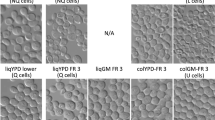Abstract
Colony development of the dimorphic yeasts Yarrowia lipolytica and Candida boidinii on solid agar substrates under glucose limitation served as a model system for mycelial development of higher filamentous fungi. Strong differences were observed in the behaviour of both yeasts: C. boidinii colonies reached a final colony extension which was small compared to the size of the growth field. They formed cell-density profiles which steeply declined along the colony radius and no biomass decay processes could be detected. The stop of colony extension coincided with the depletion of glucose from the growth substrate. These findings supported the hypothesis that glucose-limited C. boidinii colonies can be regarded as populations of single cells which grow according to a diffusion-limited growth mechanism. Y. lipolytica colonies continued to extend after the depletion of the primary nutrient resource, glucose, until the populations covered the entire growth field which was accomplished by utilization of mycelial biomass.







Similar content being viewed by others
References
Gow NAR, Robson GD, Gadd GM (1999) The fungal colony. University Press, Cambridge
Punt PJ, van Biezen N, Conesa A, Albers A, Mangnus J, van den Hondel C (2002) Filamentous fungi as cell factories for heterologous protein production. Trends Biotechnol 20:200–206
Nielsen J (1993) A simple morphologically structured model describing the growth of filamentous microorganisms. Biotechnol Bioeng 41:715–727
Boddy L (1999) Saprotrophic cord-forming fungi: meeting the challenge of heterogeneous environments. Mycologia 91:13–32
Ritz K (1995) Growth response of some soil fungi to spatially heterogeneous nutrients. FEMS Microbiol Ecol 16:269–280
Ritz K, Millar SM, Crawford JW (1996) Detailed visualisation of hyphal distribution in fungal mycelia growing in heterogeneous nutritional environments. J Microbiol Methods 25:23–28
Jacobs H, Boswell GP, Scrimgeour CM, Davidson FA, Gadd GM, Ritz K (2004) Translocation of carbon by Rhizoctonia solani in nutritionally-heterogeneous microcosms. Mycol Res 108:453–462
Olsson S, Gray SN (1998) Patterns and dynamics of 32P-phosphate and labelled 2-aminobutyric acid (14C-AIB) translocation in intact basidiomycete mycelia. FEMS Microbiol Ecol 26:109–120
Walther T, Reinsch H, Grosse A, Ostermann K, Deutsch A, Bley T (2004) Mathematical modeling of regulatory mechanisms in yeast colony development. J Theor Biol 229:327–338
Davidson FA, Sleeman BD, Rayner ADM, Crawford JW, Ritz K (1997) Travelling waves and pattern formation in a model for fungal development. J Math Biol 35:589–608
Boswell GP, Jacobs H, Ritz K, Gadd GM, Davidson FA (2007) The development of fungal networks in complex environments. Bull Math Biol 69:605–634
Boswell GP, Jacobs H, Davidson FA, Gadd GM, Ritz K (2003) Growth and function of fungal mycelia in heterogeneous environments. Bull Math Biol 65:447–477
Falconer RE, Brown JL, White NA, Crawford JW (2005) Biomass recycling and the origin of phenotype in fungal mycelia. Proc R Soc B 272:1727–1734
Davidson FA (1998) Modelling the qualitative response of fungal mycelia to heterogeneous environments. J Theor Biol 195:281–292
Davidson FA, Park AW (1998) A mathematical model for fungal development in heterogeneous environments. Appl Math Lett 11:51–56
Davidson FA, Sleeman BD, Rayner ADM, Crawford JW, Ritz K (1996) Context-dependent macroscopic patterns in growing and interacting mycelial networks. Proc R Soc Lond B 263:873–880
Walther T, Reinsch H, Ostermann K, Deutsch A, Bley T (2005) Coordinated development of yeast colonies: Quantitative modeling of diffusion-limited growth - Part 2. Eng Life Sci 5:125–133
Walther T, Reinsch H, Ostermann K, Deutsch A, Bley T (2010) Applying dimorphic yeasts as model organisms to study mycelial growth: Part 2. Application of mathematical models to identify different construction principles in yeast colonies (submitted)
Walther T, Reinsch H, Ostermann K, Deutsch A, Bley T (2005) Coordinated development of yeast colonies: experimental analysis of the adaptation to different nutrient concentrations—Part 1. Eng Life Sci 5:115–124
Varon M, Choder M (2000) Organization and cell–cell interaction in starved Saccharomyces cerevisiae colonies. J Bacteriol 182:3877–3880
Palkova Z, Devaux F, Icicova M, Minarikova L, Le Crom S, Jacq C (2002) Ammonia pulses and metabolic oscillations guide yeast colony development. Mol Biol Cell 13:3901–3914
Palkova Z, Forstova J (2000) Yeast colonies synchronise their growth and development. J Cell Sci 113:1923–1928
Palkova Z, Janderova B, Gabriel J, Zikanova B, Pospisek M, Forstova J (1997) Ammonia mediates communication between yeast colonies. Nature 390:532–536
Boschke E, Bley T (1998) Growth patterns of yeast colonies depending on nutrient supply. Acta Biotechnol 18:17–27
Dominguez A, Ferminan E, Gaillardin C (2000) Yarrowia lipolytica: an organism amenable to genetic manipulation as a model for analyzing dimorphism in fungi. In: Ernst H, Schmidt A (eds) Dimorphism in human pathogenic and apathogenic yeasts, vol 5, 1st edn. Karger, Basel, pp 151–172
Perez-Campo FM, Dominguez A (2001) Factors affecting the morphogenetic switch in Yarrowia lipolytica. Curr Microbiol 43:429–433
Atlas RM (1996) Handbook of microbiological media, 2nd edn. CRC Press, Bocaraton
Gow NAR, Gooday GW (1982) Growth kinetics and morphology of colonies of the filamentous form of Candida albicans. J Gen Microbiol 128:2187–2194
Olsson L (1999) Nutrient translocation and electrical signalling in mycelia. In: Gow NAR, Robson GD, Gadd GM (eds) The fungal colony, 1st edn. University Press, Cambridge
Acknowledgments
This work was supported by DFG grant 218147.
Author information
Authors and Affiliations
Corresponding author
Electronic supplementary material
Below is the link to the electronic supplementary material.
449_2010_442_MOESM1_ESM.tif
Schematic illustration of the experimental setup for the comparison of the growth of “cut-out” and undisturbed yeast colonies. One batch of colonies was precultured (A) until the colony interior in one half of the batch was removed after 13 days (B). Then, “cut-out” and undisturbed colonies were further cultivated up to a maximum cultivation time of 56 days (C). The asterisk represents the centre of the petri dish. The dimensions of the growth fields are the same as in Fig. 1. (TIFF 2812 kb)
Rights and permissions
About this article
Cite this article
Walther, T., Reinsch, H., Weber, P. et al. Applying dimorphic yeasts as model organisms to study mycelial growth: Part 1. Experimental investigation of the spatio-temporal development of filamentous yeast colonies. Bioprocess Biosyst Eng 34, 13–20 (2011). https://doi.org/10.1007/s00449-010-0442-6
Received:
Accepted:
Published:
Issue Date:
DOI: https://doi.org/10.1007/s00449-010-0442-6




